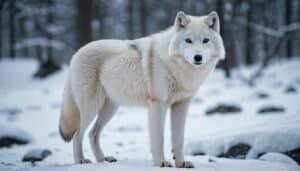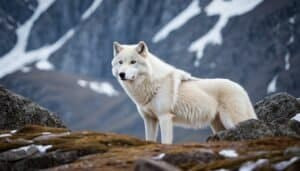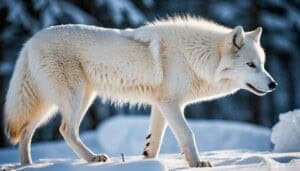Introduction
Arctic wolves are remarkable predators, perfectly adapted to the extreme conditions of the Arctic tundra. These resilient creatures face harsh weather, limited food sources, and long periods without sustenance. But when they do find prey, how much food can an Arctic wolf consume in one meal?
This article will explore their diet, meal sizes, hunting strategies, and survival adaptations. From their ability to eat large amounts of food at once to their role in the Arctic ecosystem, we’ll delve deep into the fascinating world of Arctic wolves
Understanding the Arctic Wolf’s Diet
Arctic wolves are apex predators that rely on a diverse but challenging diet to survive in the harsh environments of the Arctic tundra
With limited vegetation and prey availability, they must adapt their feeding habits to seasonal and environmental changes. Their diet reflects their role as essential components of the Arctic ecosystem, helping maintain ecological balance
What Do Arctic Wolves Eat?
The diet of Arctic wolves primarily consists of large mammals like musk oxen, Arctic hares, and caribou. These prey animals provide the necessary caloric intake to sustain the wolves through extended periods of cold and activity
According to studies by Mech (1966) and Smith (2015), Arctic wolves have also been observed consuming smaller mammals and birds when larger prey is unavailable
Unlike wolves in temperate climates, Arctic wolves face prolonged food scarcity due to the low density of prey in their habitat. This scarcity drives them to opportunistic feeding, even scavenging on carcasses left by other predators or environmental conditions
Interestingly, they exhibit a remarkable ability to digest and metabolize almost all parts of their prey, including bones and fur, ensuring no resources are wasted
Seasonal Variations in Their Diet
Arctic wolves’ dietary patterns fluctuate significantly with the changing seasons
In the summer, when prey animals are more active and reproduce, the wolves tend to hunt smaller mammals like Arctic foxes and ground-nesting birds, supplementing their intake with eggs. The abundance of prey during this time allows them to feed more frequently, storing fat reserves for the leaner winter months
During the winter, when snow and ice cover the tundra, hunting becomes more challenging. The wolves rely on their packs to take down large mammals such as musk oxen or caribou, often targeting the weak, old, or young individuals
According to Gese (2019), such hunts can involve complex strategies and high energy expenditure but yield significant rewards in the form of large meals
Typical Prey for Arctic Wolves
The primary prey species for Arctic wolves vary by region and availability. Musk oxen, which can weigh over 600 pounds, are a significant part of their diet, especially in areas with lower caribou populations
Caribou, with their migratory habits, offer seasonal opportunities for wolves to consume substantial amounts of meat. In areas with fewer large mammals, Arctic wolves turn to Arctic hares, which serve as an essential food source despite their smaller size
The diet of an Arctic wolf underscores their resilience and adaptability in one of the planet’s most inhospitable environments. Each meal reflects a balance between opportunity, effort, and survival, showcasing their critical role in the Arctic food chain
How Much Can an Arctic Wolf Eat in One Sitting?
Arctic wolves are known for their ability to consume large quantities of food in a single sitting, an essential survival trait in the unpredictable Arctic environment
This capability allows them to maximize caloric intake after successful hunts, especially when prey is scarce and meal opportunities are infrequent
Average Meal Size in Pounds
An Arctic wolf can eat up to 20% of its body weight in one meal. For an average Arctic wolf weighing approximately 100 pounds, this translates to around 20 pounds of food
Such a substantial intake is crucial for maintaining energy reserves, particularly during the winter months when prey is harder to find. According to Mech (1966), this ability enables wolves to survive extended periods without food, sometimes going days or even weeks between meals
This feeding capacity is particularly evident during large kills, such as when a pack takes down a caribou or musk ox. Wolves consume as much as possible on the spot, often competing with other pack members or scavengers like ravens and foxes
Factors Affecting Meal Size
Several factors influence how much food an Arctic wolf can consume in a single sitting. The size and availability of prey are primary determinants
Larger prey like musk oxen and caribou provide ample meat, allowing wolves to gorge. Conversely, smaller prey such as hares or birds yield less food, often necessitating multiple kills to satisfy hunger
Pack dynamics also play a role. Higher-ranking wolves typically eat first and consume the largest portions, while lower-ranking members might have to make do with less. Environmental conditions, such as extreme cold, can also affect how much a wolf eats, as energy demands increase during severe weather
Physiological Adaptations for Large Meals
Arctic wolves possess several physiological adaptations that enable them to consume and process large meals efficiently
Their stomachs are highly elastic, capable of expanding significantly to accommodate large amounts of food. This trait is critical for survival, as it allows them to maximize nutrient absorption and store energy reserves for future use
Additionally, Arctic wolves have robust digestive systems designed to handle a variety of food types, from raw meat to bones and fur
According to Smith (2015), their highly acidic stomachs help break down tough materials, ensuring efficient nutrient extraction. This capability minimizes waste and allows them to derive energy from almost every part of their prey
These adaptations are essential for life in the Arctic, where food scarcity and environmental challenges demand exceptional efficiency and resilience
The Arctic wolf’s ability to consume large meals not only sustains them through harsh conditions but also highlights their remarkable evolutionary fitness in one of the world’s most unforgiving habitats
Hunting and Feeding Behaviors of Arctic Wolves
Arctic wolves are highly strategic predators that rely on a combination of pack coordination, environmental awareness, and physical endurance to secure food in their extreme habitat
Their hunting and feeding behaviors reflect a deep adaptation to the challenges of surviving in the Arctic tundra
How Pack Hunting Influences Food Intake
The social structure of an Arctic wolf pack plays a crucial role in their hunting success and food consumption
Packs, typically consisting of five to seven members, work together to take down large prey such as caribou or musk oxen. This collaborative effort significantly increases their chances of securing a meal, particularly in a landscape where prey is sparse and highly mobile
Each member of the pack has a specific role during a hunt, from chasing prey to cutting off escape routes. According to research by Mech (2003), coordinated pack attacks can exhaust even the largest animals, making them more manageable for the wolves
Once the prey is killed, the feeding hierarchy dictates the order of consumption, with dominant wolves eating first. This system ensures the pack’s strongest members remain fit to lead and protect the group
The size of the pack and the prey often dictate how much food each wolf consumes. Larger packs may mean smaller portions for individual wolves, but the collective effort ensures survival for the group as a whole
Storing Food for Future Use
Arctic wolves exhibit an interesting behavior of caching, or storing, food for future use
This strategy is particularly valuable during times of abundance, such as after a successful hunt of a large animal like a caribou. Wolves bury portions of their kill in the frozen tundra, where natural refrigeration preserves the meat for later consumption
Caching allows Arctic wolves to maximize the utility of their kills and ensures a backup food source when hunting conditions become difficult
Studies by Ballard (1987) have shown that caching is most common during the summer months when prey availability is relatively higher, allowing wolves to prepare for the leaner winter season
However, this behavior comes with risks, as scavengers like foxes and ravens frequently raid cached food. Wolves must rely on their keen sense of smell to locate their buried meals and retrieve them before other animals do
Energy Expenditure and Meal Frequency
Hunting in the Arctic requires substantial energy expenditure, particularly when pursuing large, powerful prey or enduring long distances in search of food. As a result, Arctic wolves do not eat every day
Instead, they rely on the feast-or-famine cycle typical of many predators. After a successful hunt, wolves consume as much as possible to replenish their energy reserves
Research by Gese (2019) highlights that Arctic wolves may go several days or even weeks without food, particularly during the harsh winter months. This irregular feeding pattern underscores the importance of consuming large meals when prey is available
The balance between energy expenditure during hunting and the caloric intake from their meals is a critical aspect of their survival strategy. By optimizing their hunting techniques and leveraging pack dynamics, Arctic wolves have evolved to thrive in one of the planet’s most challenging environments
Conclusion
Arctic wolves demonstrate remarkable adaptations that allow them to thrive in one of Earth’s harshest environments
From their diet of large mammals to their ability to consume up to 20% of their body weight in a single meal, these predators showcase exceptional resilience and efficiency. Their pack hunting strategies, food caching behaviors, and physiological traits all contribute to their survival in the unforgiving Arctic tundra
Understanding the Arctic wolf’s feeding habits sheds light on the delicate balance of the Arctic ecosystem and the extraordinary measures required for life to persist in such extreme conditions
By consuming large meals, storing food, and leveraging their pack dynamics, Arctic wolves not only endure but play a vital role in maintaining the ecological stability of their frozen habitat










